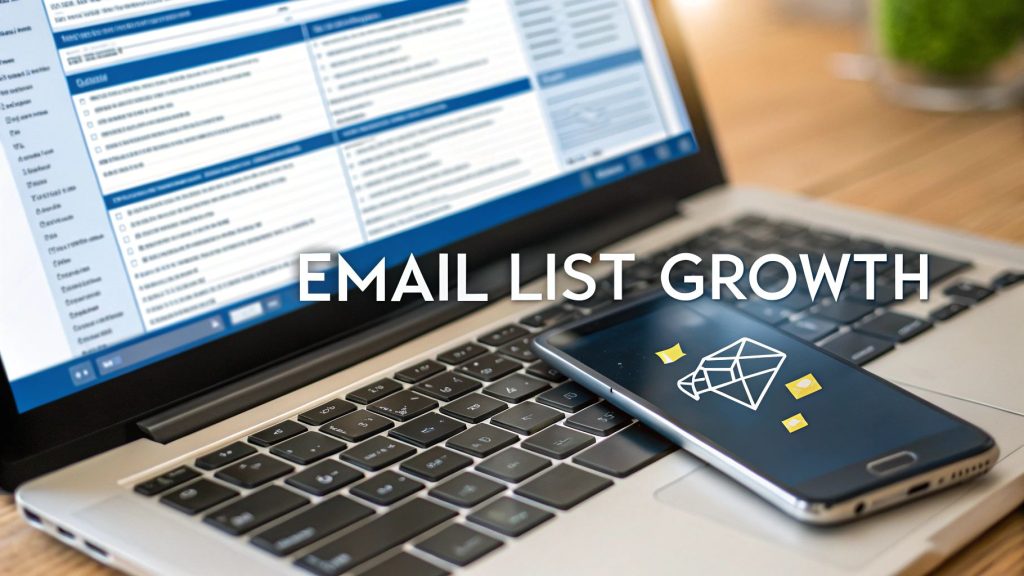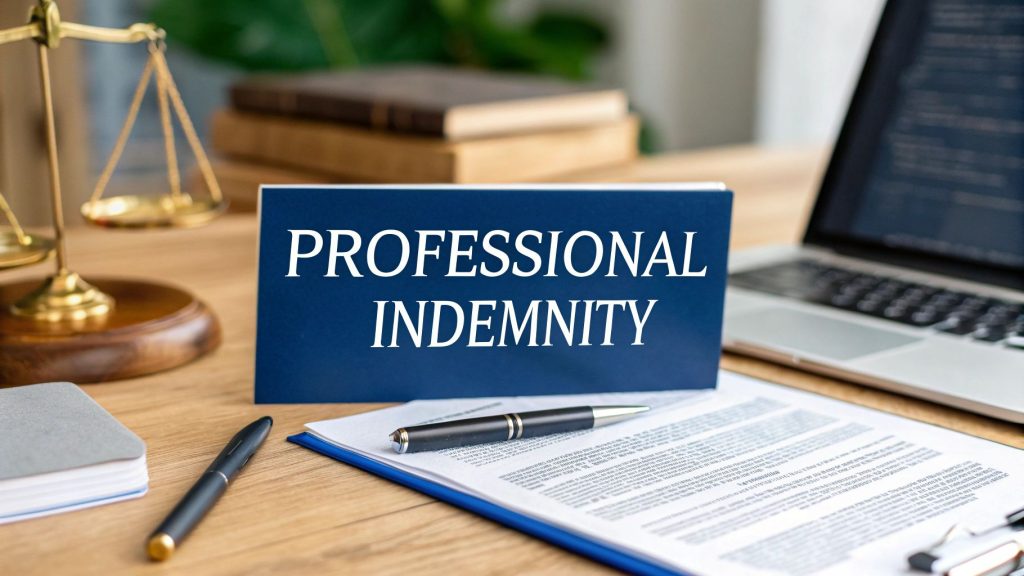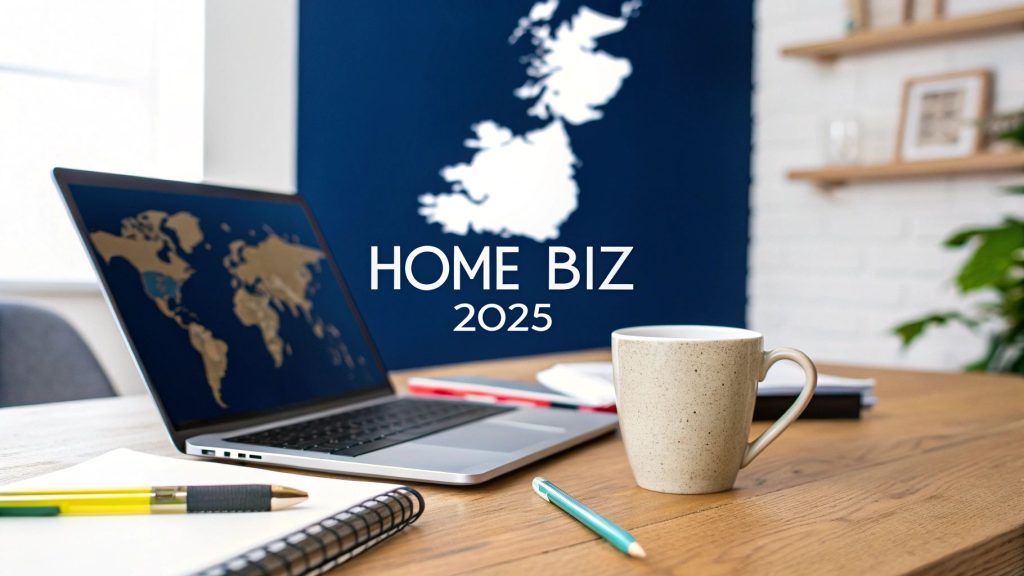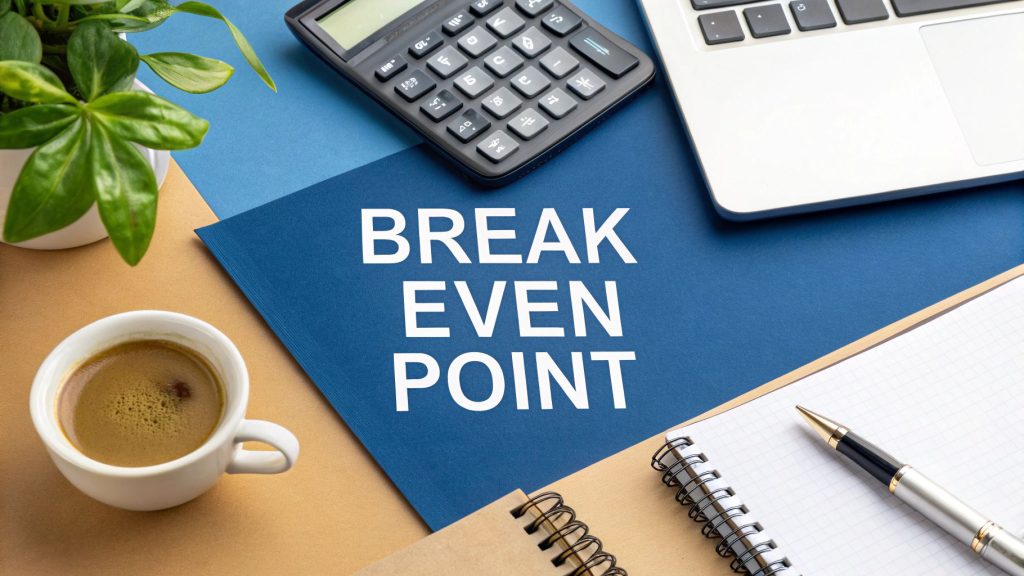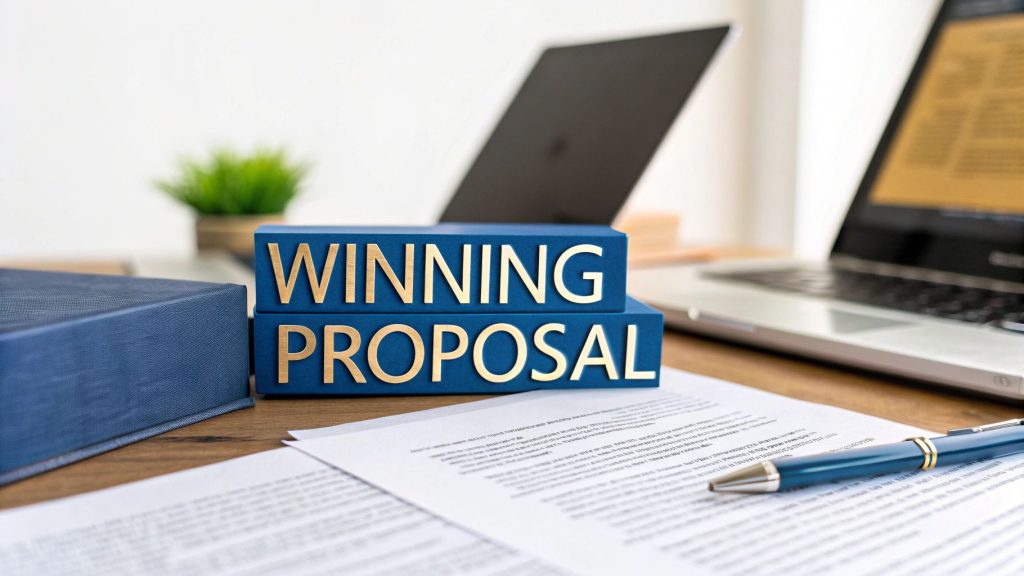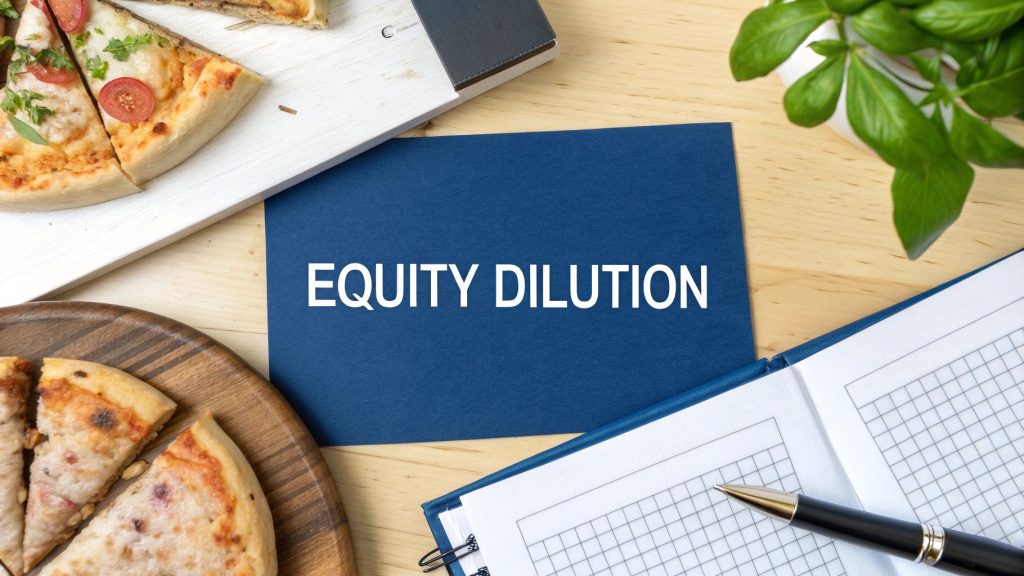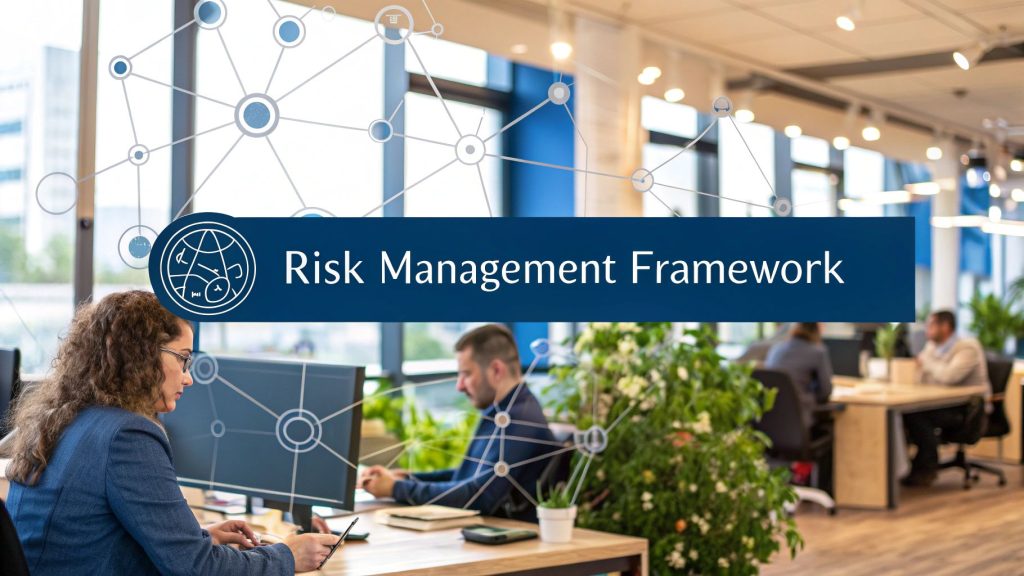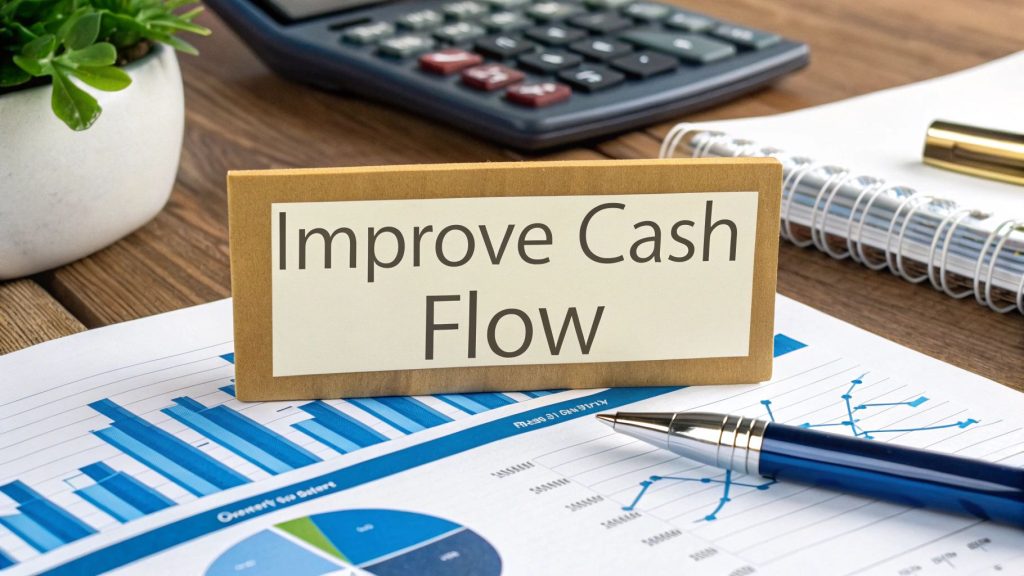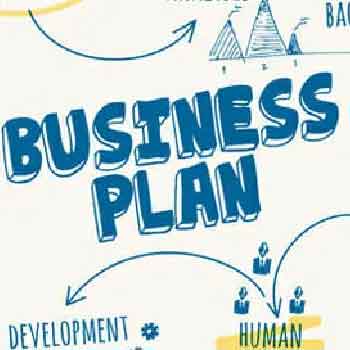Dealing with Difficult Clients: Top Strategies for Success
Dealing with difficult clients isn’t about winning arguments; it’s about shifting from a reactive defence to a proactive strategy. It all starts with understanding why a client is frustrated in the first place. Is it mismatched expectations, poor communication, or pressures you can’t even see? Once you know the root cause, you can resolve the immediate issue and, more importantly, protect the relationship. This approach turns conflict into an opportunity to strengthen your processes and prove just how valuable you are.
Decoding Client Frustration And Its True Costs

Every business, from a one-person band to a major corporation, has to handle challenging clients. It’s tempting to just label them as “difficult,” but that perspective misses a crucial truth: frustration is almost always a symptom of a deeper problem. Uncovering that root cause is the first step in moving from endless fire-fighting to smart, strategic problem-solving.
More often than not, the issue comes down to a fundamental disconnect. Maybe the initial project brief was a bit vague, or perhaps your team and the client have completely different unspoken assumptions about timelines and what the final deliverable should look like. For instance, a client might assume “website design” includes copywriting, while your team sees that as a separate service. These small gaps in understanding can easily snowball into major conflicts down the line.
Common Triggers for Client Dissatisfaction
Before you can fix a problem, you have to recognise where it’s coming from. Most difficult client situations boil down to a few common patterns that are easy to spot once you know what you’re looking for.
A classic example is a simple breakdown in communication. Picture a client who has sent a couple of emails asking for an update and heard nothing back. Their initial patience quickly turns to agitation, not because the project is delayed, but because they feel ignored and completely out of the loop. In this case, their frustration isn’t about the work; it’s about the silence.
Another frequent trigger is procedural hurdles. In the UK, recent data from the Institute of Customer Service shows that 44% of customers felt frustrated just navigating security protocols. This really highlights how internal processes, often designed for protection, can accidentally create a terrible client experience. When a client gets wound up over a complex login system or a lengthy verification process, their frustration is a direct result of operational friction. You can see more trends in the full report on the UK Customer Satisfaction Index.
Categorising Client Behaviour for a Better Response
Understanding these triggers lets you start categorising client behaviours and developing responses that actually work. By identifying the type of difficult client you’re dealing with, you can apply a much more effective strategy instead of trying a one-size-fits-all approach. This is a key part of having a proactive approach to potential issues, something we explore in our guide to a business risk management framework.
Let’s look at a few common archetypes you’ve probably met:
- The Indecisive Client: This person struggles to make firm decisions, constantly asks for just one more tiny revision, and holds up approvals for days. Their hesitation usually comes from a fear of making the wrong choice or a lack of confidence in the project’s direction.
- The Demanding Client: Known for urgent, often last-minute requests and a firm belief that their project is the only one that matters. Their behaviour is typically driven by intense pressure from their end or a genuine misunderstanding of the project scope.
- The Ghosting Client: This client vanishes for days or even weeks, failing to provide the critical feedback or approvals you need. This brings the entire project to a grinding halt. The cause can be anything from being swamped with other priorities to actively avoiding a difficult conversation.
By learning to identify these patterns, you can shift from a reactive stance to a proactive strategy. Recognising a ‘Ghoster’ early, for instance, allows you to implement a clear communication schedule from the outset to prevent disappearances.
Each of these types needs a different touch. The Indecisive Client needs reassurance and clear, simplified options to choose from. For example, instead of asking “What do you think of this design?”, try “Here are two logo options that meet the brief. Option A is bold and modern, while Option B is more traditional. Which one feels closer to your brand vision?”. The Demanding Client requires firm boundaries and transparent communication about what’s possible within the timeline. And the Ghosting Client benefits from scheduled check-ins and agreed-upon response times. By diagnosing the behaviour first, you equip yourself with the right tools to handle difficult clients far more effectively.
Mastering Proactive and Empathetic Communication
When a client relationship gets tense, your best tool isn’t a defensive email or a rigid script. It’s genuine, proactive, and empathetic communication. This isn’t about being soft; it’s about taking control, de-escalating the situation, and steering the conversation back towards a solution.
The cornerstone of this whole approach is active listening. This means more than just hearing their words—it’s about digging into the emotion and intent behind them. When a client is frustrated, what they really want is to feel heard and understood. Only then will they be open to actually solving the problem.
The Power of Active Listening and Confirmation
Real communication starts the moment the client feels you’ve actually understood them. Before you jump in to defend your work or offer a quick fix, just pause. Take a moment to reflect their concerns back to them. You’d be surprised how quickly this simple act can lower the temperature in a heated conversation.
Let’s say a client is upset because they think a project is running late. Your gut reaction might be to say, “We’re not behind, we’re just waiting for your feedback.” But an active listening approach sounds completely different.
Try something like this: “It sounds like you’re really concerned about the timeline and worried we won’t hit the launch date. Is that the main source of the frustration right now?” This question does two crucial things: it proves you were listening, and it asks for confirmation, making sure you’re tackling the right issue. It turns an accusation into a collaborative problem-solving session.
This infographic breaks down how you can structure these conversations to keep them clear and effective.
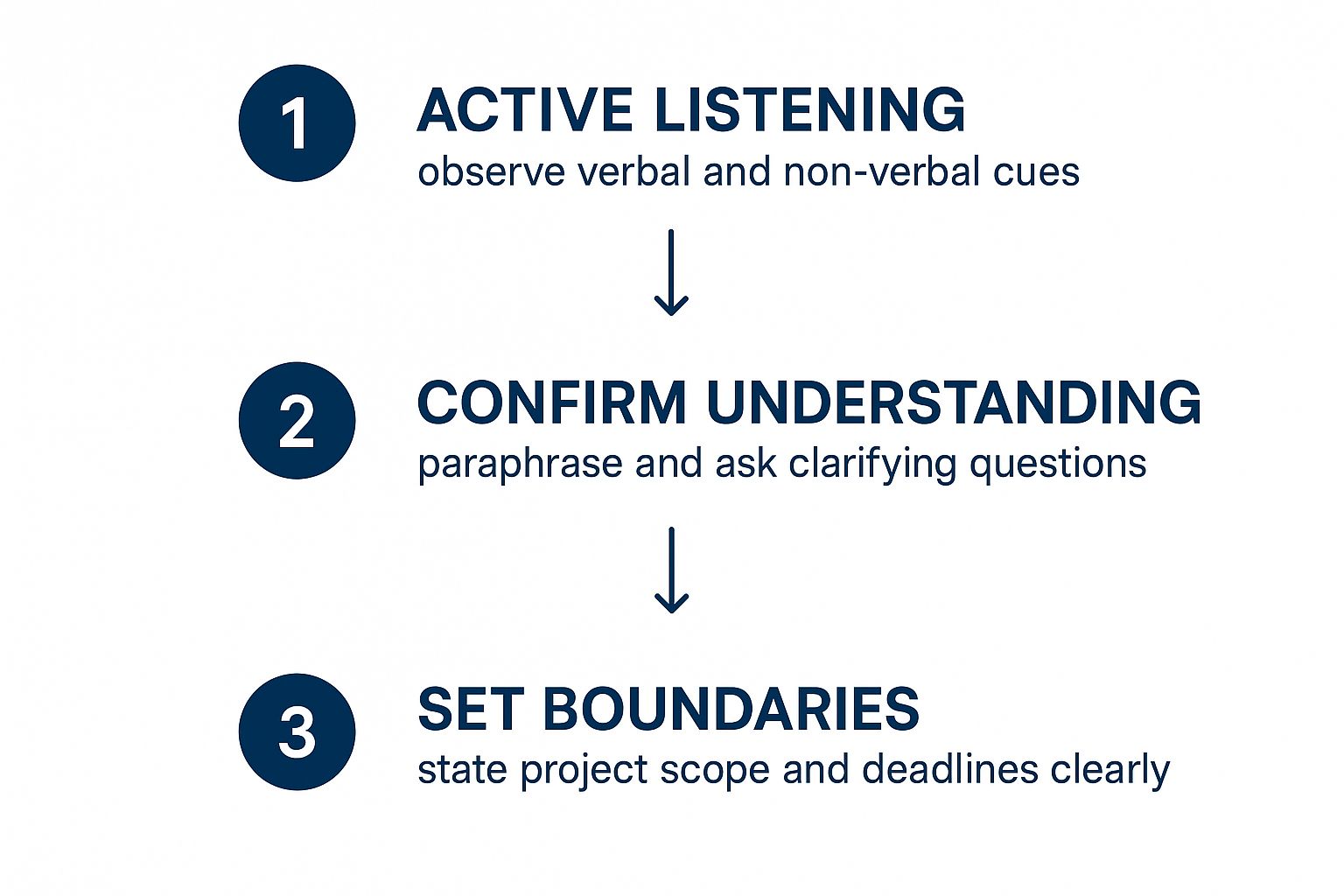
Following a flow like this ensures you properly grasp their perspective before you start suggesting solutions. It stops misunderstandings in their tracks and shows you’re committed to getting it right.
How to Set Firm and Professional Boundaries
Empathy doesn’t mean being a pushover. One of the trickiest parts of handling difficult clients is managing scope creep or impossible demands on deadlines. This is where setting clear, firm boundaries is absolutely essential.
Setting boundaries isn’t about starting a fight. It’s about professionally and politely reinforcing the agreement you both made at the start. The trick is to stay calm, be direct, and always link your boundary back to the client’s own best interests—a successful project.
Here’s how you can handle a couple of common scenarios:
- Handling Scope Creep: The client sends an email: “Could you also quickly whip up a set of social media graphics for this?” Instead of a flat ‘no’, try this: “That’s a great idea for boosting the campaign’s reach. The current scope covers the website banners we agreed on. I’d be happy to prepare a separate quote and timeline for the social graphics so we can get started on them without disrupting our current deadline.”
- Managing Deadline Pushback: A client is pushing for a much faster turnaround than is realistic. You could respond with: “I completely understand the urgency, and we’re committed to delivering the best possible result for you. To maintain the quality standards we both want, the current timeline is necessary. We could potentially explore a phased delivery if that would help get things moving sooner.”
By framing your response around shared goals (like quality and success) and offering clear options, you stay in control without making the client feel ignored. It turns a potential conflict into a strategic conversation.
Maintaining a Calm and Professional Tone
Your tone of voice—whether it’s on a call or in an email—will either pour fuel on the fire or put it out. Even if a client is being hostile, keeping your cool is non-negotiable. Getting emotional in your reply only makes things worse and undermines your professionalism.
If you get an aggressive email, don’t reply immediately. Draft your response, then walk away for an hour. This little pause gives you time to strip out the emotion and focus on the facts and a clear path forward. Always start your reply by acknowledging their frustration before you dive into the details.
A simple template for a calm reply could look like this:
“Hi [Client Name],
Thanks for getting in touch. I can see you’re frustrated with [the specific issue], and I want to get this sorted for you.
To make sure I’m on the same page, my understanding is that [briefly paraphrase the problem].
Here’s what I suggest as our next step… ”
This approach validates their feelings, clarifies the issue, and immediately shifts the conversation into solution mode. This kind of calm, structured communication is the key to handling difficult clients effectively.
When things get heated with a client, our first instinct is often to jump on the defensive. We fire back with emails explaining our side, listing facts and figures, and before we know it, the situation has spiralled. Dealing with difficult clients isn’t about winning an argument; it’s about moving past emotion and into a structured, calm process.
Having a clear framework isn’t about reading from a script. It’s a repeatable way to take the heat out of a conflict and steer everyone towards a sensible solution. It’s a logical flow that starts with making the client feel heard, then moves into figuring out what’s actually going on, and ends with finding a way forward together. If you skip the first part, you’ll never get to the last.
Acknowledge and Validate First
Before you can solve a single thing, the client has to feel heard. The very first step, always, is to acknowledge their frustration and validate how they’re feeling. It doesn’t matter if you agree with them or not. This simple act of empathy can instantly lower the emotional temperature of the entire conversation.
Imagine a client is furious because a project has gone over budget. Your gut reaction might be to list all the valid reasons for the increase, but that will just make them feel like you’re dismissing their concerns.
Instead, start by validating their feelings. A powerful opening line could be something like: “I understand you’re concerned about the budget, and I want to be completely transparent about where the costs have landed. It’s important we’re on the same page, so let’s walk through this together.”
Right away, you’ve framed the conversation as a partnership, not a fight.
Gather Facts, Not Assumptions
Once the client feels like you’re listening, you can shift gears into fact-finding mode. The key here is to approach the situation with genuine curiosity, not defensiveness. Your only goal is to understand their perspective fully and gather all the information needed, without making any assumptions.
Use open-ended questions to get them talking. Sticking with the over-budget scenario, you could ask:
- “Could you tell me which specific costs were surprising or felt unexpected to you?”
- “Can you walk me through your understanding of the original scope? I want to see where the disconnect might be.”
- “What was your expectation for the final budget on this part of the project?”
This approach turns an argument into an investigation. It shows you’re taking them seriously and are committed to understanding the whole picture before jumping to solutions.
Collaboratively Explore Solutions
With the emotion dialled down and the facts on the table, you can finally move into problem-solving. This is where you work with the client to find a path forward. Don’t just dictate a single solution. Instead, present a couple of viable options and explain the pros and cons of each one. This gives the client a sense of control and empowers them to be part of the resolution.
In our over-budget example, you could present options like this:
Option 1: The Phased Approach. “We can complete the most critical components now, staying within the original budget. Then, we can schedule the remaining ‘nice-to-have’ features for a second phase when you have more budget available.”
Option 2: The Adjusted Scope. “Let’s look at the remaining work and identify a few lower-priority features we could simplify or remove. This would bring the project back in line with the initial budget without sacrificing the core functionality.”
By presenting choices, you completely change the dynamic. You’re no longer the source of the problem; you’re a strategic partner helping them navigate a challenge.
To help structure this process, here’s a simple framework you can mentally follow whenever a conflict arises.
Four-Stage Conflict Resolution Framework
This table breaks down the process into clear, manageable stages. Think of it as a roadmap to guide you from a tense situation to a productive outcome.
| Stage | Objective | Key Actions | Example Phrase |
|---|---|---|---|
| 1. Acknowledge | De-escalate emotion and show you’re listening. | Validate their feelings without admitting fault. Use empathetic language. | “I understand why you’re frustrated, and I want to help sort this out.” |
| 2. Investigate | Understand the root cause from their perspective. | Ask open-ended questions. Avoid making assumptions. Gather all the facts. | “Can you walk me through exactly what happened from your point of view?” |
| 3. Collaborate | Find a mutually agreeable path forward. | Present 2–3 viable options with clear pros and cons. Empower them to choose. | “We have a couple of ways we can approach this. Let’s find the one that works best for you.” |
| 4. Document | Ensure clarity and prevent future issues. | Send a follow-up email summarising the discussion and agreed actions. | “Just to confirm our chat, we’ve agreed to move forward with Option A…” |
Following a structured approach like this not only resolves the immediate issue but also builds trust for the long term.
The Importance of Documentation
Throughout this whole process, meticulous documentation is your best friend. After every important phone call or meeting, send a follow-up email summarising what was discussed and what you both agreed to. This isn’t just about covering your own back; it’s about creating clarity and stopping future misunderstandings in their tracks.
A quick summary email becomes the single source of truth that both you and the client can refer to. It massively reduces the risk of “he said, she said” arguments down the line. It also shows you’re organised, professional, and in control of the situation. This methodical approach is critical, especially when you consider that a huge number of disputes stem from simple miscommunication.
For example, recent data from the UK Financial Ombudsman Service showed that 31% of formal complaints were upheld in the consumer’s favour, which highlights just how often client dissatisfaction is found to be justified. You can discover more insights from the official complaints data. By using a clear framework, you can resolve issues long before they ever get to that point, protecting your client relationships and your business.
Balancing Technology with a Human Touch

In the rush to be more efficient, it’s all too easy to lean on technology when a difficult client situation arises. While modern tools can streamline your workflow, they can never fully replace the power of genuine human connection. The real skill is striking the right balance between tech-driven efficiency and authentic empathy.
This isn’t about ditching your software; it’s about using it smarter. A good Customer Relationship Management (CRM) system, for instance, is far more than just a digital address book. Think of it as your communication library, holding the entire history of a client relationship.
Using Technology to Enhance Empathy
Before picking up the phone or writing an email to a frustrated client, a quick look at their CRM record gives you crucial context. You can instantly see past conversations, previous issues, and what was agreed. This simple preparation stops you from asking redundant questions and shows the client you’re on top of their history.
For example, imagine a client is upset about a recurring technical glitch. Instead of starting from scratch, you can open with: “Hi, Sarah. I’ve been reviewing our notes from last month, and I can see we tried resolving this with X and Y. I’m really sorry it’s happened again; let’s figure out a more permanent fix for you.”
This simple act demonstrates that you value their time and remember their struggles, building an immediate foundation of trust.
This approach is vital, especially when recent findings show that almost 47% of UK consumers have experienced poor customer service in the last year. This widespread dissatisfaction really underscores how important every single interaction is. You can read the full research on UK consumer experiences to get a better sense of the challenges businesses face.
The Role of AI as an Assistant, Not a Replacement
Artificial intelligence can play a fantastic supporting role here, too. AI tools are excellent at summarising long, complex email chains or suggesting initial, fact-based responses to common queries. This frees up your team’s time and mental energy to focus on the more nuanced, strategic side of the conversation.
Think of AI as your pre-flight checklist. It can gather the facts and outline the situation, but a human pilot—you—still needs to handle the take-off and landing.
The most effective strategy is letting technology handle the data so your team can focus on the relationship. AI can draft a summary, but only a person can deliver it with genuine empathy and understanding.
This balance is crucial because empathy is your ultimate competitive advantage. While technology can manage processes, a human touch is what truly strengthens relationships and improves client loyalty. It’s one of the most important customer retention strategies a business can master.
Knowing When to Pick Up the Phone
Perhaps the most important skill of all is knowing when to ditch the keyboard entirely.
If an email exchange goes back and forth more than twice without getting anywhere, or if you detect even a hint of rising tension, it’s time for a phone call. The tone, nuance, and immediate feedback of a real conversation are simply irreplaceable.
Here are a few scenarios where a phone call should be your go-to:
- When delivering bad news: Updates about project delays or budget issues should always be discussed directly to manage the emotional response.
- When a misunderstanding is brewing: If you sense an email has been misinterpreted, a quick call can clear things up in seconds, avoiding a lengthy and frustrating back-and-forth.
- After a problem is resolved: A follow-up call a day or two later to check in and ensure the client is truly happy with the solution shows you care beyond just closing the ticket.
One personal, well-timed phone call can resolve an issue that dozens of emails failed to fix. It reminds the client that there’s a real person on the other side who is invested in their success, turning a tricky situation into a moment that actually strengthens the relationship.
Knowing When and How to End a Client Relationship

No matter how hard you try to fix things, some client relationships just turn sour. Learning when to walk away isn’t about giving up; it’s a crucial business skill. It’s a strategic move to protect your company’s health, your team’s sanity, and your ability to serve the clients who actually appreciate what you do.
Hanging on to a toxic client relationship is a massive drain on your resources, time, and energy, often for very little profit. Think of the opportunity cost—every hour you spend placating a difficult client is an hour you can’t invest in growing your business or delighting your best customers. Knowing when you’ve reached the point of no return is essential for long-term survival.
Identifying the Critical Red Flags
Sometimes, a client is just having a tough time during a stressful project. Other times, their behaviour points to a partnership that’s fundamentally broken. The trick is telling the difference between a temporary hiccup and a permanent problem.
Keep an eye out for these persistent red flags. If they keep showing up, it might be time to part ways:
- Consistent Disrespect: This isn’t just a bit of frustration. If a client is repeatedly rude, dismissive, or abusive towards you or your team, a serious line has been crossed. An example would be a client who uses demeaning language in emails (“Did you even read the brief?”) or shouts at staff members during calls.
- Chronic Late Payments: A client who always pays late, questions every single invoice, or tries to renegotiate terms after you’ve done the work is a huge financial risk.
- Endless Scope Creep: This is the client who constantly demands more work that falls way outside the agreed scope, without any respect for the extra budget or time needed.
- Fundamental Mismatch in Values: If a client’s ethics or business practices just don’t sit right with your own, the relationship is never going to feel good or be sustainable.
Spotting these patterns early helps you make a logical decision, not an emotional one. Once one or more of these red flags becomes a regular feature, it’s time to start planning your exit.
The Professional Playbook for Parting Ways
Ending a client relationship has to be handled with care and professionalism to avoid any negative fallout. The goal is to be firm, clear, and graceful. You want to leave no room for misunderstanding while protecting your reputation.
The objective isn’t to win a final argument but to execute a clean, professional disengagement. This protects your business and allows you to refocus your energy on productive partnerships.
Before you do anything, your first port of call is always your contract. It should have a termination clause spelling out the exact process for ending the partnership, including notice periods and final payment duties. Understanding your contractual rights is non-negotiable—it’s the legal foundation for everything that follows. If you need a refresher, our guide explains in detail how to protect your business with contracts and agreements.
Executing a Smooth Handover
Once the decision is made, your focus should shift to a smooth and organised handover. This shows your professionalism right to the very end and stops the client from claiming you left them in the lurch.
A clean break involves a few key steps:
- Complete or Document All Work: Finish any outstanding jobs that are realistic within the notice period. For anything left unfinished, create crystal-clear documentation on the project’s status, handing over all relevant files, assets, and login details.
- Prepare the Final Invoice: Tally up the final bill, making sure to itemise all completed work as laid out in your contract. Be ready to explain it and have all the supporting documents on hand.
- Craft a Professional Termination Letter: The last step is to put your decision in writing. This email or letter needs to be polite, direct, and firm. Don’t get emotional or write a long essay justifying yourself. Simply state your decision, refer to the contract’s termination clause, specify the end date, and outline the next steps for the handover and final payment.
For instance, your letter could say something like: “After careful consideration, we have decided to terminate our service agreement, effective [Date]. We will ensure a smooth handover of all project materials by [Handover Date] and will send the final invoice for all completed work shortly.” This approach is professional, final, and leaves little room for argument, allowing everyone to move on.
Your Client Management Questions, Answered
Navigating tricky client relationships throws up a lot of questions. Even with the best intentions, certain situations pop up time and again. Here are my thoughts on some of the most common dilemmas I see people facing.
What’s the First Thing I Should Do When a Client Is Angry on the Phone?
When a client is clearly fuming, your first instinct might be to get defensive or immediately try to fix the problem. Don’t. Your single most important job in that moment is to listen without interrupting and validate their feelings.
An angry client needs to feel heard before they’ll even consider a solution. Just let them get it all out. Once they’ve finished, reflect their main point of frustration back to them. Something as simple as, “I can hear how incredibly frustrating this has been for you, and I completely understand why you’re upset,” can work wonders.
This isn’t about admitting fault. It’s about acknowledging their emotion, which is the key to de-escalating the whole situation. Only after they feel understood should you start asking questions to figure out a fix.
How Do I Stop Client Issues from Happening in the First Place?
Honestly, the best way to handle difficult client situations is to prevent them from ever starting. Prevention really boils down to two things: clarity and proactive communication, right from day one. Your best tools for this are a solid contract and a regular communication schedule.
A detailed contract isn’t just a legal document; it’s a rulebook for your relationship. It sets clear expectations for scope, deadlines, deliverables, and payment, which stops ambiguity from turning into a full-blown conflict later on.
Beyond that, you need to be proactive with your updates:
- Weekly Status Emails: A quick, consistent update reassures the client that things are moving forward, even if there isn’t much to report. It keeps them in the loop.
- Scheduled Calls: For bigger projects, regular calls are perfect for clearing up small misunderstandings before they spiral into major problems.
This approach ensures everyone stays on the same page and dramatically cuts the risk of a relationship going sour.
The goal is to create a partnership where surprises are minimised and transparency is maximised. This transforms your client relationship from a reactive one to a collaborative one.
Is It Ever Okay to Admit I Made a Mistake?
Absolutely. Not only is it okay, but admitting a mistake can actually build more trust than trying to pretend you’re perfect. When you’ve genuinely messed up, a sincere and prompt apology is one of the most effective ways to repair a client relationship.
But an apology alone isn’t enough. For it to work, you need two things:
- Sincere Ownership: Acknowledge the mistake clearly, without making excuses. For example, “You’re right, we missed that requirement, and I am truly sorry for the oversight.”
- A Concrete Action Plan: Immediately follow up with what you’re doing to fix it. Something like, “I’ve already assigned our senior developer to correct this, and we’ll have an updated version for you to review by 3 p.m. tomorrow.”
That combination of humility and decisive action shows real integrity. It proves to the client that you’re accountable and committed to making things right, which can turn a potential disaster into a moment that actually strengthens your long-term partnership.
Managing client relationships is a cornerstone of any successful business. At Grow My Acorn, we provide the resources and advice you need to build stronger partnerships and navigate business challenges with confidence. Find more insights at https://growmyacorn.co.uk.


